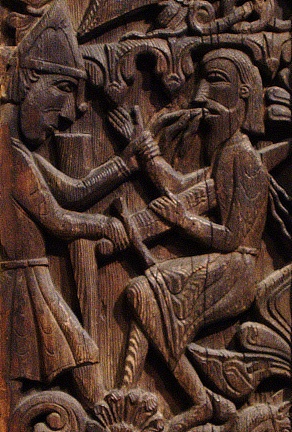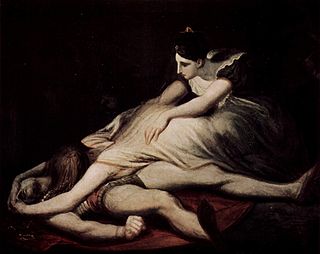
The Völsunga saga is a legendary saga, a late 13th-century prose rendition in Old Norse of the origin and decline of the Völsung clan. It is one of the most famous legendary sagas and an example of a "heroic saga" that deals with Germanic heroic legend.

In Norse mythology, Reginn is a son of Hreiðmarr and the foster father of Sigurð. His brothers are Fáfnir and Ótr.
In Norse mythology, Hreiðmarr is a sorcerer. He is featured in the Völsunga saga and in Snorri Sturluson's Prose Edda.

In Germanic heroic legend and folklore, Fáfnir is a worm or dragon slain by a member of the Völsung family, typically Sigurð. In Nordic mythology, he is the son of Hreiðmarr, and brother of Regin and Ótr and is attested throughout the Völsung Cycle, where, Fáfnir slays his father out of greed, taking the ring and hoard of the dwarf Andvari and becoming a worm or dragon. Fáfnir's brother Regin later assisted Sigurð in obtaining the sword Gram, by which Fáfnir is killed. He has been identified with an unnamed dragon killed by a Völsung in other Germanic works including Beowulf, the Nibelunglied and a number of skaldic poems. Fáfnir and his killing by Sigurð are further represented in numerous medieval carvings from the British Isles and Scandinavia, and a single axe head in a Scandinavian style found in Russia. The story of Fáfnir has continued to have influence in the modern period, such as in the works of J.R.R Tolkien, who drew inspiration from the tale of Fáfnir in his portrayals of Smaug and Gollum.
In Norse mythology, Borghild was the first wife of Sigmund. They had two sons, Hamund and Helgi.

In Norse mythology, Gram, also known as Balmung or Nothung, is the sword that Sigurd used to kill the dragon Fafnir. It is primarily used by the Völsungs in the Volsunga Saga. However, it is also seen in other legends, such as the Thidrekssaga in which it is wielded by Hildebrand.
In Völsunga saga, Rerir, the son of Sigi, succeeds his murdered father and avenges his death. He rules in Hunaland and becomes a powerful ruler. Rerir's son is Völsung.

In Scandinavian heroic legend, Grani is a horse owned by the hero Sigurd. He is the horse that Sigurd receives through advice from Odin. Grani is a descendant of Odin's own steed, Sleipnir.

In Abrahamic and European mythology, medieval literature and occultism, the language of the birds is postulated as a mystical, perfect divine language, Adamic language, Enochian, angelic language or a mythical or magical language used by birds to communicate with the initiated.

Dragons, or worms, are present in Germanic mythology and wider folklore, where they are often portrayed as large venomous serpents. Especially in later tales, however, they share many common features with other dragons in European mythology.

Guðrúnarkviða I or the First Lay of Guðrún is simply called Guðrúnarkviða in Codex Regius, where it is found together with the other heroic poems of the Poetic Edda. Henry Adams Bellows considered it to be one of the finest of the eddic poems with an "extraordinary emotional intensity and dramatic force". It is only in this poem that Gjúki's sister Gjaflaug and daughter Gollrönd are mentioned, and the only source where Herborg, the queen of the Huns, appears. The Guðrún lays show that the hard-boiled heroic poetry of the Poetic Edda also had a place for the hardships of women.
In the Völsung cycle, Sigi is the ancestor of the Völsung lineage. In the Völsunga saga, he is said to be one of the sons of Odin. He is also listed among Odin's sons in the Nafnaþulur. He has a son called Rerir.
Riðill or Refil is a sword that appears in Norse Mythology, possessed by the dwarf Regin.

Sigurðarkviða hin skamma or the Short Lay of Sigurd is an Old Norse poem belonging to the heroic poetry of the Poetic Edda. It is one of the longest eddic poems and its name derives from the fact that there was once a longer Sigurðarkviða, but this poem only survives as the fragment Brot af Sigurðarkviðu.

The Sigurd stones form a group of eight or nine Swedish runic inscriptions and one picture stone that depict imagery from the Germanic heroic legend of Sigurd the dragon slayer. They were made during the Viking Age and constitute the earliest Norse representations of the matter of the Völsung cycle that is the basis of the Middle High German Nibelungenlied and the Sigurd legends in the Poetic Edda, the Prose Edda, and the Völsunga saga.

In Norse mythology, Barnstokkr is a tree that stands in the center of King Völsung's hall. Barnstokkr is attested in chapters 2 and 3 of the Völsunga saga, written in the 13th century from earlier tradition, partially based on events from the 5th century and the 6th century, where, during a banquet, a one-eyed, very tall man appears and thrusts a sword into the tree which only Sigmund is able to pull free. Scholarly theories have been put forth about the implications of Barnstokkr and its relation to other trees in Germanic paganism.

A dragonslayer is a person or being that slays dragons. Dragonslayers and the creatures they hunt have been popular in traditional stories from around the world: they are a type of story classified as type 300 in the Aarne–Thompson classification system. They continue to be popular in modern books, films, video games and other forms of entertainment. Dragonslayer-themed stories are also sometimes seen as having a chaoskampf theme - in which a heroic figure struggles against a monster that epitomises chaos.

Sigurd or Siegfried is a legendary hero of Germanic heroic legend, who killed a dragon—known in some Old Norse sources as Fáfnir—and who was later murdered. In both the Norse and continental Germanic tradition, Sigurd is portrayed as dying as the result of a quarrel between his wife (Gudrun/Kriemhild) and another woman, Brunhild, whom he has tricked into marrying the Burgundian king Gunnar/Gunther. His slaying of a dragon and possession of the hoard of the Nibelungen is also common to both traditions. In other respects, however, the two traditions appear to diverge. The most important works to feature Sigurd are the Nibelungenlied, the Völsunga saga, and the Poetic Edda. He also appears in numerous other works from both Germany and Scandinavia, including a series of medieval and early modern Scandinavian ballads.

The Legend of Sigurd and Gudrún is a book containing two narrative poems and related texts composed by English writer J. R. R. Tolkien. It was published by Houghton Mifflin Harcourt and HarperCollins on 5 May 2009.

The Story of Sigurd the Volsung and the Fall of the Niblungs (1876) is an epic poem of over 10,000 lines by William Morris that tells the tragic story, drawn from the Volsunga Saga and the Elder Edda, of the Norse hero Sigmund, his son Sigurd and Sigurd's wife Gudrun. It sprang from a fascination with the Volsung legend that extended back twenty years to the author's youth, and had already resulted in several other literary and scholarly treatments of the story. It was Morris's own favorite of his poems, and was enthusiastically praised both by contemporary critics and by such figures as T. E. Lawrence and George Bernard Shaw. In recent years it has been rated very highly by many William Morris scholars, but has never succeeded in finding a wide readership on account of its great length and archaic diction. It has been seen as an influence on such fantasy writers as Andrew Lang. The Story of Sigurd is available in modern reprints, both in its original form and in a cut-down version, but there is no critical edition.


















